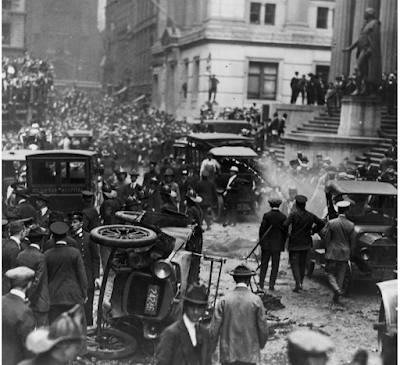Several developers in the third quarter of the 19th century attempted to better the living conditions of the working class residents of Hell's Kitchen by replacing dilapidated brick and wooden houses with substantial flat buildings. In 1883 developer William Rankin set out to erect another at 460 West 49th Street, just east of Tenth Avenue. Architect C. F. Ridder filed plans on January 26, projecting the construction costs at $12,000 (about $335,000 in 2023). Known for his tenement designs, Ridder was busy in the area. On the same day he filed plans for another five-story tenement two blocks away for another operator.
The brownstone-faced building was textbook Ridder. Its Renaissance Revival design featured classic, triangular pediments above the openings on the second and fourth floors. The fluted brackets that upheld the molded cornices of the upper floor windows can be seen in Ridder buildings elsewhere. At the first floor, he borrowed from Romanesque Revival for the undressed stone and the arched openings. The formal, double-doored entrance was crowned by a faux balcony.
Rankin was a real estate operator, not a landlord, and he sold 460 West 49th Street on October 1, 1885 to Nicholas Joost for $18,000. He made a tepid profit of $175,000 in today's money on his investment.
Living here in 1902 was Richard W. Young, who found himself in the middle of a near-race riot that spring. Racial tensions in Hell's Kitchen were severe. Blacks were unofficially banned on blocks inhabited by whites and gang violence was common. Twenty-one-year old Holmes Esley, who lived on West 32nd Street, south of Hell's Kitchen, may have been unaware of the "rules." At any rate, he became involved in a street fight on April 12 that year, and at one point tried to flee for his life.
The New York Press began its report saying, "With angry cries of 'Stop thief!' 'Stop thief!' an excited crowd of policemen, citizens and nondescripts ran down Eighth avenue last night in hot pursuit of a young negro, who was waving his arms right and left to beat off his pursuers." Patrolman Timothy Sullivan joined in the chase and nearly overtook him, but "the hunted man turned and made a slash with a razor at the officer." Sullivan drew back in time to receive only a slash in his uniform and a scratch on his arm. Richard W. Young and another pedestrian were in the path of the mob. The New York Press reported they "tried to block the progress of the fleeing negro, but quickly abandoned their scheme when the fugitive slashed at them."
Sullivan drew his service revolver and warned Esley to stop, firing a warning shot in the air. When the panicked young man continued to run, Sullivan shot him. The incident was not over, but was about to get worse. The article continued, "A large number of negroes gathered and their indignation ran high when they learned that one of their race had been shot by a policeman. Cries of 'Kill the cop,' and the like were raised." A platoon of officers arrived just in time to prevent what the newspaper predicted would have been "a race riot."
Holmes Esley was arrested and taken to Roosevelt Hospital. The charges of felonious assault against him were filed by Richard W. Young.
Domestic violence was common in the Hell's Kitchen tenements. Living at 460 West 49th Street in the summer of 1911 were Herman Deiser and his wife. A confrontation between the two became serious on the afternoon of June 9 that year. Deiser's wife fled for her life from the building with him right behind with a large knife. After running several blocks, according to The New York Press, Mrs. Deiser ran to two women on the street for help. The knife-welding Deiser now turned his wrath (and his weapon) on them before he was arrested and carted away by police. He was charged with felonious assault.
Before World War II, the stoop sported beefy cast iron newels and railings. image via the NYC Dept of Records & Information Services
Other tenants, of course, simply wanted to live quietly and make an honest living. One such resident named Ahern placed a position-wanted advertisement in the New York Herald on April 3, 1911. "Chauffeur and mechanic; four years' shop experience; two years driving on Stearns, Lozier, Peerless, Pope-Hartford."
On September 16, 1920 resident Joseph Black was downtown in the Financial District. Exactly what he was doing there is unclear, but he was in the wrong place at a very wrong time. Anarchists had been terrorizing the country with home-made bombs, targeting bankers and businessmen in early examples of domestic terrorism. Just before noon that day a mail carrier opened the letter box at Cedar Street and Broadway and found a hand-written note: “Remember we will not tolerate any longer. Free the political prisoners or it will be sure death for all of you. American Anarchists Fighters.”
Carnage and chaos followed the noon bombing of the J. P. Morgan building on September 16, 1920. image via fbi.gov/history
Minutes later a horse-drawn cart packed with 1,000 pounds of dynamite and 500 pounds of metal, chunks of iron sash weights, and other shrapnel, exploded on the Wall Street side of the J. P. Morgan bank building at 23 Wall Street. It was a massive explosion, instantly killing 31 and injuring at least 300 innocent citizens. Among them was Joseph Black. The Sun reported that he was among those taken to St. Vincent's Hospital.
Change came to Hell's Kitchen in the last decades of the 20th century. A renovation of C. F. Ridder's handsome brownstone begun around 2015 resulted in a restored exterior and one apartment on each floor.
photographs by the author
LaptrinhX.com has no authorization to reuse the content of this blog




.png)
No comments:
Post a Comment